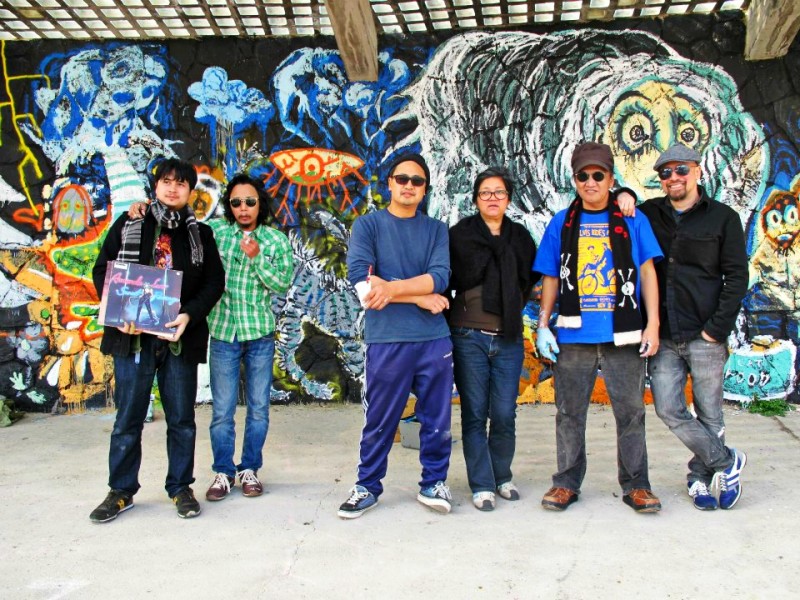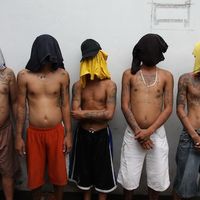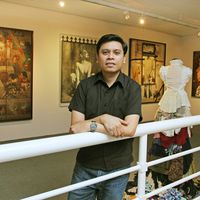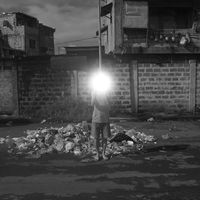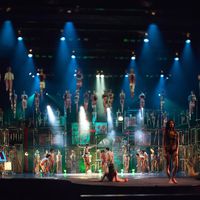French-Filipino tandem introduces Philippine contemporary art to France
 Contributed by Lai Del Rosario
Contributed by Lai Del RosarioManila Vice is a group exhibition of 23 artists from the Philippines which is currently showing at the Musée International des Arts Modestes (MIAM) in Sète, France. It is curated by Manuel Ocampo, an internationally recognised Filipino artist, in partnership with MIAM founder and fellow artist Hervé Di Rosa, and Pascal Saumade, the museum’s resident curator. Through thought-provoking, satirical, and at times shocking contemporary art pieces, the exhibit aims to present Manila to France as a living and breathing cultural hub with a unique identity. The show has already made a significant impact in Sète, with a front-page feature in Midi Libre and an off-shoot art project taking place between the participating artists and a local art and music festival. Given all this, Manila Vice is a good example of a fruitful artistic collaboration between the Franco-Philippine art communities. It is also proof of France’s growing interest in the Philippines, whose art and culture remain relatively undiscovered by the French audience.
Philippine art is making headway this year in France. For their main exhibition this spring, the Musée International des Arts Modestes (MIAM) in Sète have decided to focus on Manila. Manila Vice, curated by Manuel Ocampo, is a collective show of 23 contemporary artists from the Philippines. The show aims to feature works that suggest the unique personality of Filipino culture - humorous, sarcastic, and sometimes perverted.
Manila is a place with 20 million inhabitants. It has been a port and trade centre since the 1500s, and has seen the reign of Spain, Great Britain, the United States, and Japan through the years. Today, it is a hodgepodge of classic European architecture, American urban planning, and shanties brought about by poverty. From its Southeast Asian roots, cosmopolitan vibe, and Catholic underpinnings, Manila is a place of contrast and texture. Given these qualities, it is no wonder that Ocampo has chosen it as the theme for his latest project.
Manila Vice includes artists who are able to show their personality in their art. “I like art that is like Manila, which is unsafe, sleazy, sexy, dirty, subversive, politically incorrect,” says Ocampo. He wanted to present the city as a living and breathing cultural hub with an unusual, if sometimes confused, identity. The result is an exhibit - made up of paintings, photographs, sculptures, videos, and art installations - that either shocks, tickles, or invites viewers to get to know Manila through artistic expressions and exploits. Dina Gadia, for one, has come up with a disturbing yet amusing stylised image that seemingly combines remnants of vintage comics, cheesy B-movies, and Americanised popular art in the Philippines. Painter, musician, vinyl collector - among others - Romeo Lee, himself having a sort of "identity crisis", presents a flurry of surrealistic paintings on the museum's widest wall while not forgetting to perform punk songs on the opening night. Installation artist Kawayan de Guia, on the other hand, mocks the idea of war by transforming aerial bombs into flamboyant disco balls.
Manuel Ocampo is a Philippine-born painter who lived and studied in California for years before deciding to move back to Manila to settle down. His art combines punk and religious iconography and are political or satirical. He has exhibited the world over, in the Venice Biennale and Berlin Biennale among others, and his works often allude to his Filipino heritage. In 2010, he curated his first big exhibit, Bastards of Misrepresentation, which opened in the Freies Museum in Berlin. The show similarly examined contemporary Philippine society and featured mainly Filipino artists.
When asked how Manila Vice developed, Ocampo recounts, “It came about when the artist, Hervé Di Rosa, with the help of Pascal Saumade, invited me to curate a show. The museum is focusing on unfamiliar art scenes outside of the typical art centres. Last year, the museum directed their attention to the art scene in Winnipeg, Canada.” As Di Rosa describes,
MIAM is a place that “provokes encounters that will never happen elsewhere, welcomes artists that are unknown in the area, forgets the conventions of the art market and institutions, and attempts to go against rules that often limit contemporary art.”
With Manila Vice, MIAM has proven to be a good platform for presenting “undiscovered” art, particularly contemporary Philippine art which is otherwise still unknown or often overlooked in Europe.
Hervé Di Rosa, French artist and co-founder of MIAM, wanted to introduce to France mind-blowing art pieces from a city he describes as wild and “stronger than our most unimaginable dreams and nightmares”. He went to Manila in 2011 on an artist residency, was impressed by the Filipino artists he met - notably punk icon Romeo Lee - and has since wanted to work with them. During his stay, he incidentally had a one-man show, Hervé di Rosa - MANILA, in Ocampo’s gallery.
Thanks to Di Rosa’s endorsement, Manila Vice was supported by the Embassy of France in the Philippines who then helped with promotion and public relations. Meanwhile, Pascal Saumade, resident MIAM curator, worked alongside Ocampo and oversaw the logistics.
When asked if he sees the exhibit as a collaboration between France and the Philippines, Ocampo explains, “I would say that it is a collaboration between artists. The French Embassy would not have supported us if Hervé had not pushed for the project.” But Ocampo also expressed dismay, complaining that no Filipino institution supported his cause, save for the Vice-Consul of the Philippine Embassy, André Estanislao, who came to the inauguration from Paris.
On the day of the opening, billboards screaming “Manila Vice by Manuel Ocampo” adorned the streets of Sète, quite an unexpected image for a city with no immediately recognisable links to a country in Southeast Asia. On the other hand, it wasn’t hard to see how the show succeeded in catching the attention of the community. The opening night gave way to a full house, while Midi Libre, Sète’s local newspaper, came out with a front-page feature the day after announcing how Philippine art “heated up” the MIAM. In the meantime, participating artists Romeo Lee, Carlo Ricafort, and Jayson Oliveira were invited to be part of K-Live, a local festival promoting urban art. The result was the creation of a mural found in one of Sète’s landmark spaces in the Place de la Revolution. This collaboration further proves the community’s appreciation of Philippine art.
But it seems that Sète is not the only region in France paying attention to the Philippines. Another exhibit, this time supported by the Quai Branly Museum in Paris, has also opened this spring. Archipelago of Exchange (“Archipel des échanges”) is a show revolving around Philippine artefacts dating back to pre-colonial time and is dubbed as the first major exhibition in France dedicated to the Philippines. The Embassy of France describes it as “an excellent venue in strengthening Franco-Philippine relations in culture and the arts.”Archipelago of Exchange and Manila Vice, while different in theme, share one objective in common - to present Philippine art and culture to France by exhibiting works that are rarely seen or heard of in Europe.
These milestones should serve to encourage further artistic collaborations between the Philippines and other countries in Europe. In fact, plans are already in motion to bring Manila Vice to Santander, Spain. These initiatives are also a good platform for exchange, discovery, and association between seemingly distant cultures. Lastly, they serve as a reminder for artists to continue cultivating and making use of their networks, and for institutions to be more cognisant of these valuable partnerships.
Manila Vice is on display in MIAM until September 2013.
For more information about the exhibit and participating artists, please see https://culture360.asef.org/event/Sète-france-manila-vice-exhibition/.
References:
http://www.miam.org/telechargements/dossier%20de%20presse%20Manila.pdf
http://www.ambafrance-ph.org/Herve-di-Rosa-Manuel-Ocampo.
http://www.sete.fr/index.php/Accueil?idpage=61&idmetacontenu=2531
http://www.ambafrance-ph.org/Herve-di-Rosa-Manuel-Ocampo
http://www.manilaartblogger.com/2011/12/17/herve-di-rosa-in-manila/
http://asemus.museum/event/paris-largest-exhibition-indigenous-filipino-art/
Lai del Rosario is a freelance writer and photographer. She started her professional writing career in 2006 as a copywriter in an advertising agency and has since been writing articles on culture, lifestyle, art exhibitions, and taking photographs of her adventures and travels.
She is currently based between France and Switzerland.
Similar content
from - to
13 Apr 2013 - 22 Sep 2013
from - to
09 Apr 2013 - 14 Jul 2013
from - to
03 May 2012 - 11 Jun 2012

